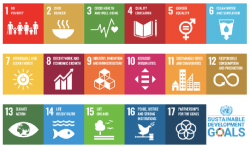The role of the industry, and the benefits of the material, play a role in achieving almost all Sustainable Development Goals:
• durable and cost-effective buildings and infrastructure are central to the transformation of communities out of poverty, providing education at all levels and combatting food waste.
• transport infrastructure made with concrete provides market access for local food producers, promotes access to education and creates economic opportunities and well-being.
• as a global industry, cement and concrete manufacturing drives economic growth and provides both direct and indirect employment; and, as an industry, we are committed to providing fair and safe working conditions.
• across the world, concrete is the material of choice for transporting water, providing clean drinking water and effective sanitation.
• concrete is integral to generating and transporting clean energy, whether by building hydro-electric dams, providing foundations for wind turbines or power lines, or infrastructure for tidal power or geothermal power.
• the unique reflective properties and thermal mass of concrete contribute to the energy efficiency for our built environment.
• as this document demonstrates, the cement and concrete industry is committed to net zero concrete by 2050, eliminating its climate impact.
• the strength and the unique resistance of concrete to both water and fire protects communities around the world from natural disasters and the effects of climate change.
• concrete is fundamental to the provision of resilient affordable housing for vulnerable urban communities.
• the cement and concrete industry is at the heart of the circular economy, using by-products from other industries as raw material or fuel, and by providing a product that can be repurposed or recycled.

